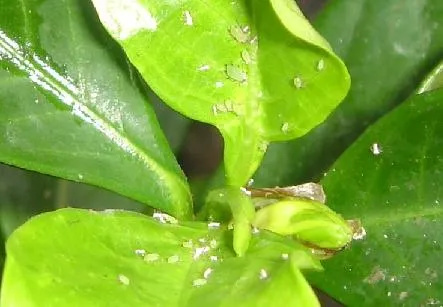Bonsai Pests: Getting rid of Aphids
Aphids can be a common pest for those who grow bonsai in temperate climates. They cause damage to the trees by feeding off of the sap and occasionally introducing viruses to the host plant in the process. Left unchecked aphid damage can weaken or kill your bonsai so recognizing an infestation and knowing how to stop it is important for the health of your bonsai collection.

What Aphids Look Like
Aphids are often green in color with a teardrop shaped body usually under an 8th of an inch in size. It is not uncommon to find tan and yellow aphids as well. Their legs appear to protrude slightly out from their body when viewed from the top. They use their stylets to passively ingest the sap from the bonsai they are praying upon. Aphids are normally without wings however birth may be given to winged aphids when they find themselves in poor areas for feeding. This allows them to more easily seek out new plants to feed on.
The Connection Between Ants and Aphids
Often times if you notice ants on your bonsai it is a sign you may also have aphids. This is because ants actually farm aphids for a byproduct the aphids produce called honeydew. The ants protect the aphids from other insects that would normally feed on them so that they can collect the sugary honeydew the aphids excrete.
Signs of Aphid Damage
Aphids leave characteristic damage to bonsai and plants that they feed on. Some signs can include leaves that become distorted or crinkled, flower buds that drop off, damaged flower buds, and strange looking flowers. Often times damage will cause the tips of the leaves to have the most distortion. If aphids feed on the bottom of the leaf it will have a tendency to curl backward and around them. Additionally, the presence of sooty mold fungus or sticky honeydew (which the mold feeds on) is usually an indication of aphids.
How to get rid of aphids
You can do several things to get rid of aphids from your bonsai collection.
- Physical removal (water blast)
- Chemical sprays
- Get natural predators to help
Remove aphids with water blast
Aphids can be physically knocked off your bonsai trees with a high pressure jet of water or spray from your garden hose. This is usually a good first step as it is the least expensive, less likely to weaken the tree, and least invasive or harmful to beneficial bugs. Be careful not to knock them off into the soil as they will just come back.
Chemical sprays - insecticidal soap
If you find blasting the aphids off with water is not enough to control them you can use insectidal soap. Aphids are a soft bodied insect and the insectidal soap increases the permeability of their body causing them to leak out. Insectidal soap only kills on contact. Once it dries it is ineffective on any future bugs so spread out applications may be necessary. Its helpful to spray at a time of the day where it won't dry out immediately. Be sure to cover the tops and bottoms of the leaves. If your local store does not carry insectidal soap we have a home-made recipe for insectidal soap here. Also note this can kill most beneficial insects in the area of application as well. For a more natural approach you an buy or encourage predatory bugs.
Aphid predators - Predatory bugs
Many insects eat, predate on, aphids and employing them is a much better approach than using insectides. Insects that eat aphids include ladybugs, aphid midges, spiders, and praying mantis. In some areas you can buy these insects from nurseries. If you keep your bonsai outdoors you can also plant dill, angelica, geraniums, and alyssum in your garden. These plants are natural attractants of many predatory insects. Often, when aphids become a problem it is due to lack of natural predatory insects when bonsai are kept indoors or in an outdoor enclosure the predators can't get into.
